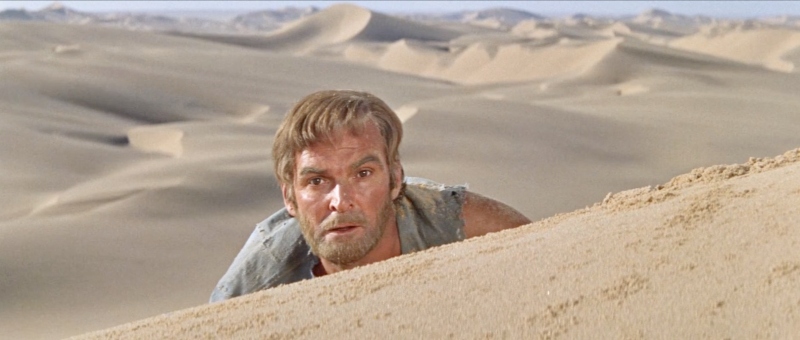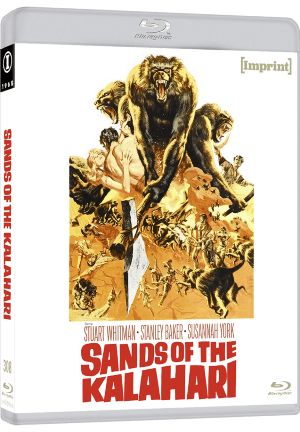Come for the adventure, stay for the baboon fight.
australian label printed films, a fantastic line from the ViaVision label, releases older movies on Blu-ray every month. Most have their own release, but the label has done a good job of putting together a few titles in box sets that celebrate directors, genres, and more. His adventure stories The series began last year with a celebration of “Arabian” adventures, while the second collection set its sights on the thrills of the jungle. Adventure Tales: Collection Three finds its thrills from Algeria to Norway and features a roster of big names including Burt Lancaster, Kirk Douglas, Richard Harris, Anthony Quinn and more.
The new release once again comes in a sturdy hard case with each film in its own case. The four discs are region-free and the games are limited to 1,500 copies only. Now read on to see all four films in the new Adventure Tales: Collection Three!
Contents
 Ten Tall Men (1951)
Ten Tall Men (1951)
Sergeant. Kincaid (Burt Lancaster) is a fun-loving member of the French Foreign Legion, but he’s very professional when it comes to wooing the ladies and taking down bad guys. News of an imminent attack on his outpost tasks him with holding off the invaders until reinforcements arrive, but to do so he’ll need a little help from a handful of rogues, thieves, and scoundrels.
While Adventure Tales: Collection Three It is a box of undeniable goodness, The tall men It is unfortunately its weakest link. The film began as a serious Western before Lancaster and his friends changed course and turned it into a comedy-filled foreign adventure. However, neither of the two options seems to have been correct.
The French Legion itself is a solid enough setting for an exciting story, as the African landscape and warring factions offer dramatic conflict and struggles, but director Willis Goldbeck is unable to deliver a convincing or compelling experience. This never feels like Morocco, much less Africa, instead vacillating between Southern California and minimally dressed soundstages. That lack of tactile atmosphere immediately crushes any attempt at suspense, excitement or drama. Worse still, however, are the film’s comedic efforts that fail at every turn as the big bad guys are hit over the head and defeated through slapstick.
Ultimately, it is Lancaster who makes the film watchable. Always the acrobat, he turns Kincaid into a lively, forceful guy, prone to knocking others out and rolling as a form of defense. It’s funny, but the script thinks it’s funny too, and that’s where the two diverge. Like the film itself, Lancaster tries to elicit laughs, but instead it all feels silly and lacks stakes. The central idea here (the “bad” kids stepping up and doing good) is best fulfilled in something like The dirty dozen (1967) or The seven magnificents (1960).
Region free, no extras.
 The Telemark Heroes (1965)
The Telemark Heroes (1965)
The small town of Telemark sits in the middle of Norway’s beautiful mountains next to a beautiful, serene lake, but all is not well. It’s World War II, the country is occupied by German soldiers, and the Nazis are producing heavy water to use in atomic bombs. It’s the kind of thing that could tip the war in their favor, and the only hope of stopping it lies with a small group of Norwegian resistance fighters.
This Paramount war epic is not highly regarded, or even well remembered, but watching it now sparks an appreciation for old-school films of this type. A big draw here is the basis of a true story, and director Anthony Mann takes the production to the same city where it all took place. We are watching things happen in the same streets, factory and lake where, without exaggeration, Hitler’s best chance to acquire an atomic weapon was stopped. That alone adds a level of interest to the film.
Mann’s direction ensures that the ensemble maintains that interest as well, while creating a compelling blend of drama, espionage and action. It’s far from action-packed, but the methodical nature of the film has its own appeal as we progress step by step with the resistance and their plan. You can feel the bitter cold that permeates the outdoor scenes, elevated even further as the Nazi threat collides with the beauty of the surroundings on the way to a satisfying conclusion.
Kirk Douglas, Richard Harris and Michael Redgrave take the lead here and they all do a good job. Douglas plays a physicist who’d rather keep the ladies warm than take on the Nazis, but Harris’s young freedom fighter convinces him how important his effort is. The character drama can disappoint at times, but Douglas and Harris, in particular, are rarely less than charismatic and engaging.
Region free, with the following extras.
- *NEW* Commentary by film historians Steve Mitchell and Steven Jay Rubin
- *NEW* The making of The Telemark Heroes [1:24:43]
- *NEW* Playing a hero: interview with actor David Weston [17:58]
- Norway Location Reports [43:21]
- Weymouth Location Report [12:41]
- Interview with Richard Harris on site [6:13]
- Interview with Michael Redgrave on location [4:24]
- Interview with Ulla Jacobsson outdoors [4:33]
- Interview with Anthony Mann on site [4:40]
- Interview with Kirk Douglas at Pinewood Studios [5:58]
 Sands of the Kalahari (1965)
Sands of the Kalahari (1965)
A small charter plane takes off to fly over the Kalahari Desert, but when a strange swarm of locusts disables the engines, the plane and its passengers crash into the hot sands. The survivors (six men and one woman) appear to work together initially, but it isn’t long before fear and ego begin to shake their efforts. Add to that dehydration, hunger, and a nearby pack of territorial baboons, and things get even worse. And then, of course, you have to deal with a shirtless Stuart Whitman.
Writer-director Cy Endfield delivers an incredible survival story here (my favorite film of the set, by far) that works wonderfully as both a traditional survival story and an exploration of humanity’s animalistic tendencies. A character shares his knowledge of baboons, describing their tribal nature, the dominance of a single male, and the ownership the beast assumes over females, and it’s not long before we begin to witness humans evolving differently. similar.
The message is never intended to be as precise as, for example, something like lord of the flies, but similar issues are at play here. Whitman’s Brian O’Brien is an experienced hunter and comes armed with a rifle, a chest, and some opinions on masculinity. He’s fantastic in the role, exuding a sweaty confidence that draws viewers and the lady (Susannah York) into his orbit – well, at least until he starts actively disposing of the other men whom he sees as a waste of resources and threats. to your domain. .
Endfield shot the film on location and it is an effective choice that brings the audience into the harsh desert landscape alongside the characters. His fight unfolds with suspense and gentle action beats, and watching Whitman’s descent into his animalistic ways is at times thrilling. The baboons don’t come into play as much as an eco-horror fan like me would have liked, but they get the last laugh with a pretty spectacular ending that plays out only to the sounds of nature barking on the TV. It’s a great film that deserves more attention.
Region free, with the following extras.
- *NEW* Commentary by film historian Scott Harrison
- *NEW* Sounds of the Kalahari: Interview with Sound Camera Operator Arkadi de Rakoff and Clapper Loader Douglas Milsome [32:42]
 Lost Commando (1966)
Lost Commando (1966)
A French army lieutenant colonel fights and loses an epic battle in Vietnam, but finds new opportunities after being liberated from a prisoner of war camp. It’s called failing upward, and for Pierre Raspeguy (Anthony Quinn), it’s the path he takes toward Algeria as part of France’s fight against the resistance. He assembles a ragtag group of soldiers, including men he previously fought alongside, but soon discovers that one of those men is now the leader of the resistance he is going to fight.
Director Mark Robson, or at least his first and second stage directors, pull off some solid battle scenes here that capture the explosive chaos of the battlefield. They are one of the two highlights and although they are mostly relegated to the beginning and end of the film, they still add to the energy. Scenes are given room to breathe with a variety of wide shots showing scale and tighter sequences showing individual character beats.
However, the film is a little less successful outside of the battlefield, as the different character dramas are not equally compelling. Quinn is fantastic as the disgraced soldier looking for a second chance at military success, but as good as those elements are, his more intimate scenes are a mixed bag. Alain Delon has the most interesting role as a captain who tires of war, but what to do with the terribly misguided George Segal: that of a dark-faced Algerian officer. Wild things.
The same year saw the release of The Battle of Algiers, and that’s the one you want for a more serious and thought-provoking look at the French attempt to quell the rebellion. However, if you’re okay with a simpler approach, one more interested in audience approval and entertaining satisfaction, then this should scratch the wartime cinema itch.
Region free, no extras.
Buy Tales of Adventure: Collection Three from Imprint Films!
Related topics: lancaster, Home video, Print, kirk douglas

 Ten Tall Men (1951)
Ten Tall Men (1951) The Telemark Heroes (1965)
The Telemark Heroes (1965) Sands of the Kalahari (1965)
Sands of the Kalahari (1965) Lost Commando (1966)
Lost Commando (1966)